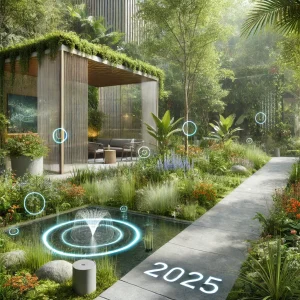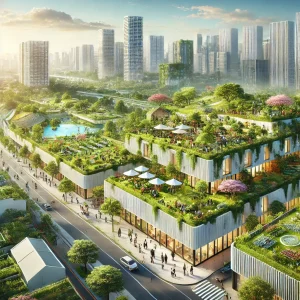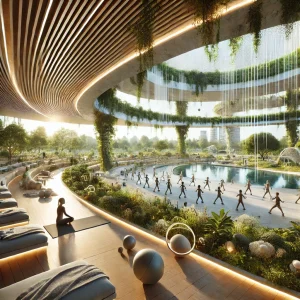Biophilic design has gained significant traction in recent years, especially in urban and commercial landscapes. As we move into 2025, this design philosophy will evolve even further, focusing on creating healthier, more connected outdoor environments. Biophilic design, which integrates natural elements into built spaces, enhances aesthetic appeal and promotes well-being by fostering a deeper connection between humans and nature. This blog will explore the emerging biophilic design trends for 2025 and how they reshape our outdoor spaces.

The Rise of Biophilic Design
Biophilic design rests on the idea that humans have an innate connection to nature and that integrating natural elements into our living and working environments can enhance well-being, productivity, and creativity. In outdoor spaces, this design approach involves more than just adding plants or water features; it emphasizes creating environments that harmonize with nature, promote sustainability, and improve the quality of life for users.

Key Trends in Biophilic Design for 2025
Integration of Smart Technology
In 2025, designers will integrate greater smart technology with biophilic design. Smart sensors, automated irrigation systems, and climate control features will maintain optimal conditions for plant life while minimizing water and energy use. These technologies support sustainability and enhance the user experience by making outdoor spaces more responsive to the needs of both people and nature.
Multisensory Experiences
Biophilic design in 2025 will increasingly focus on creating multisensory experiences. Designers will incorporate elements that engage sight, sound, smell, touch, and taste. For instance, gardens with aromatic plants, water features that produce calming sounds, and textured surfaces that invite touch will become more common. These elements create a more immersive experience, fostering a deeper connection with the natural environment.
Green Infrastructure and Urban Rewilding
As cities grow, the need for green infrastructure becomes more critical. In 2025, we will witness a surge in urban rewilding initiatives—projects that bring more natural elements into urban areas. This includes creating green roofs, living walls, and community gardens that beautify cities, support biodiversity, and help mitigate climate change impacts. Designers will craft these spaces to serve as natural habitats for wildlife, helping restore ecosystems within urban environments.
Health and Well-being as a Central Focus
The link between nature and health has been well-documented, and in 2025, this connection will take center stage in biophilic design. Designers will intentionally create outdoor environments to promote physical and mental health. This could include designing spaces for outdoor exercise, meditation, and social interaction, while incorporating elements that reduce stress and improve mood. Access to natural light, fresh air, and green spaces will receive priority in public and private outdoor areas.
Sustainable and Locally-Sourced Materials
Sustainability will continue to drive biophilic design. In 2025, designers will emphasize using locally sourced, sustainable materials with minimal environmental impact. This includes utilizing reclaimed wood, natural stone, and eco-friendly finishes. By choosing durable and sustainable materials, designers can create outdoor environments that are both beautiful and environmentally responsible.

The Future of Biophilic Design
As we look ahead to 2025, it’s clear that biophilic design will play a crucial role in shaping the outdoor environments of the future. By integrating natural elements with cutting-edge technology, designers can create spaces that are not only aesthetically pleasing but also promote health, well-being, and sustainability. Whether in urban parks, commercial landscapes, or private gardens, the biophilic design trends of 2025 will help us reconnect with nature in meaningful ways, creating environments that are healthier, more sustainable, and deeply connected to the natural world.

Incorporating these trends into your outdoor spaces can significantly impact both the environment and the people who use them. As we continue to explore the possibilities of biophilic design, the future of our outdoor environments looks greener, healthier, and more connected than ever before.